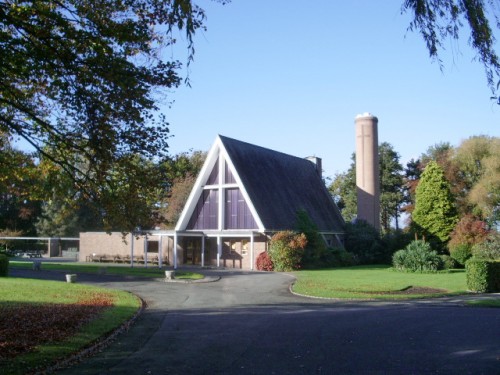Obviously, any building created by the state at the behest of its citizens should be faith-neutral. It’s a given, it goes without saying, so why say it?
Because the Co-op seems to have fallen foul of an unholy alliance of some townspeople of Shrewsbury in the matter of its £1.7 million refurb of the town’s crematorium.
Built in unenlightened times, Shrewsbury crem is distinguished, as you can see from the photo, by a large cross on its steeply pitched front gable, and another on its chimney of all places.
Reading between the lines of the newspaper report it looks as if the Co-op had quite properly resolved to get rid of the crosses until local vicar Revd Murray McBride assembled a posse of, I don’t know, Christian conservationists or somesuch, and, by means which are not described, corrupted the moral fibre of the Co-op and caused it to backtrack. Said a Co-op spokesperson, “The Co-operative Group is not altering the crematorium in any other way so we are able to confirm that the chimney and crosses will remain.”
We don’t question the earnest wellmeaningness of the Revd McBride, but sorry, mate, you don’t speak for everyone. A cross can only ever be an opt-in.
McBride asserts that “From a design point of view [the crematorium] is a great example of a building from the 1950s or 60s and the crosses form an integral part of that.”
What do you think?
Story in the Shropshire Star here



It’s an interesting question and, speaking as a non-Christian, I’d be happy to not have the cross there. BUT How many people actually notice? I asked this, because when I trained to be a celebrant, many of my local colleagues were complaining about the crematorium used by many members of my family. The complaint was that the staff were very unwilling to take the cross down. I couldn’t have told you where the cross was because when I was there and grieving, I wasn’t looking for it. So I’m happy for crosses to stay, as long as there are also… Read more »
Thanks for that, XP. You make some very good points — ie, ones I hadn’t thought of!
I suspect this is one of the things that is noticed by “us who are into this sort of thing” but un-noticed by the other 99% of the population (or whatever the figure is, probably more than that).
The cross looks as though it supports the front elevation, and possibly the steeply pitched front gable. The staff feared that if it went, well, so did the building.
Similarly, the cross on the chimney looks as if its integral to the structure – a neat piece of brickworking.
But your general point is right…we are a secular society within which people practice many religions, so the cross should be, as you so rightly say an ‘opt in’.
The stunning picture window at Glynn Valley Crematorium incorporates an image of the cross. It does not dominate but still occupies a focal point for mourners. I have an original architects drawing for the chapel which shows that in the original design there was not meant to be any religious symbolism incorporated into the structure – the cross-beam was clearly ‘sneaked’ in later.
Richard, who’d have thought you’d have that! Thank you very much indeed. The plot thickens – and the conservation case arguably thins.
It does indeed look like a modern, mid-20th century church whereas crematoria are indeed places for funerals of those of many faiths and none. I’d agree that new architecture should reflect this multi-faith/secular status, but do see the point of maintaining it as an example of the architecture of the time. The main cross is certainly imposing but it does also look like it serves a structural and design function.
The cross at the front does appear to support the main gable, though it wouldn’t be beyond the wit of even an apprentice architect to remove it as well as the relief brickwork one on the chimney, given the will.
But it’s the will that’s the issue. Had history been otherwise, for instance, there could just conceivably have been a swastika in its place – wouldn’t we have been a lot more enthusiastic about removing that?